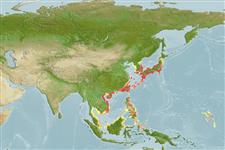Environment: milieu / climate zone / depth range / distribution range
Ecology
Marine; reef-associated; non-migratory; depth range 2 - 15 m (Ref. 7247). Subtropical
Northwest Pacific: southern Japan, Ryukyu Islands, Taiwan, and China.
Size / Weight / Age
Maturity: Lm ? range ? - ? cm
Max length : 17.0 cm TL male/unsexed; (Ref. 9710)
Dorsal spines (total): 13 - 14; Dorsal soft rays (total): 11 - 14; Anal spines: 2; Anal soft rays: 10 - 12. This species is distinguished by the following set of characters: D XIII-XIV,11-14 (mode XIII,13); A II,10-12 (11); pectoral-fin rays 16-20 (19); principal caudal-fin rays 15; spiniform caudal-fi�n
rays 2; scale rows in longitudinal series 23-28 (26); tubed lateral line scales 16-21 (17); scale rows above lateral line 4-5 (4), below lateral line 11-12 (11); gill rakers 7-10 (9) + 19-24 (21) = 27-33 (30); preopercular margin smooth; caudal fi�n deeply forked no prolongedfi�laments;a prominent black blotch covering upper two-thirds of pectoral �n base throughout life; indistinct white spot at end of dorsal fin base; caudal peduncle no distinct markings; broad dark band along each caudal fin lobe (Ref. 94774).
Adults inhabit inshore and offshore coral or rocky reefs (Ref. 7247). Oviparous, distinct pairing during breeding (Ref. 205). Eggs are demersal and adhere to the substrate (Ref. 205). Males guard and aerate the eggs (Ref. 205). Diurnal species (Ref. 52881).
Life cycle and mating behavior
Maturity | Reproduction | Spawning | Eggs | Fecundity | Larvae
Oviparous, distinct pairing during breeding (Ref. 205). Eggs are demersal and adhere to the substrate (Ref. 205). Males guard and aerate the eggs (Ref. 205).
Iwatsubo, H. and H. Motomura, 2013. Redescriptions of Chromis notata (Temminck and Schlegel, 1843) and C. kennensis Whitley, 1964 with the description of a new species of Chromis (Perciformes: Pomacentridae). Spec. Div. 18:193-213. (Ref. 94774)
IUCN Red List Status (Ref. 130435: Version 2024-2)
Threat to humans
Harmless
Human uses
Tools
Special reports
Download XML
Internet sources
Estimates based on models
Preferred temperature (Ref.
123201): 18.9 - 28.5, mean 24.9 °C (based on 360 cells).
Phylogenetic diversity index (Ref.
82804): PD
50 = 0.5000 [Uniqueness, from 0.5 = low to 2.0 = high].
Bayesian length-weight: a=0.01622 (0.00970 - 0.02713), b=3.04 (2.90 - 3.18), in cm total length, based on LWR estimates for this species & Genus-body shape (Ref.
93245).
Trophic level (Ref.
69278): 3.4 ±0.45 se; based on food items.
Resilience (Ref.
120179): Medium, minimum population doubling time 1.4 - 4.4 years (Preliminary K or Fecundity.).
Fishing Vulnerability (Ref.
59153): Low vulnerability (10 of 100).
Nutrients (Ref.
124155): Calcium = 55.4 [23.5, 94.5] mg/100g; Iron = 0.725 [0.394, 1.323] mg/100g; Protein = 19.1 [17.9, 20.3] %; Omega3 = 0.16 [0.08, 0.30] g/100g; Selenium = 9.86 [4.42, 21.57] μg/100g; VitaminA = 83.1 [21.4, 321.0] μg/100g; Zinc = 0.863 [0.523, 1.383] mg/100g (wet weight);
